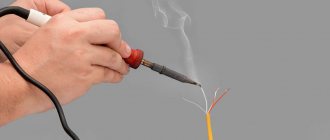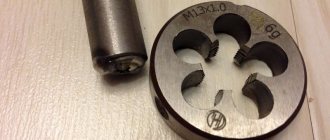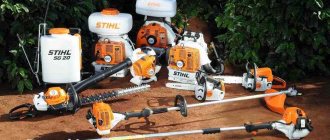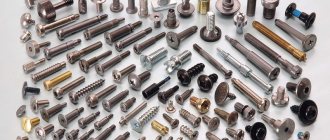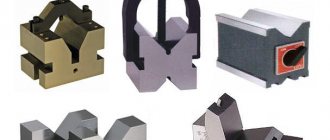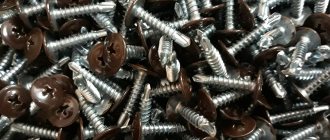- Design
- Thread type
- Direction of thread being cut
Every craftsman knows what a die or tool is, but it will be very useful for beginners in plumbing to study our article. In it we will give answers to the following questions.
- What are dies and what are they used for?
- What design features does the tool have?
- How is a die different from a lerka?
- What types of dies are used in plumbing?
- What are they made of?
- How to use dies?
Rules for cutting threads using dies
Only if the established rules of work are observed, it is possible to obtain a surface with high precision and quality. A die for cutting external threads must be used in conjunction with a special driver, through which force is transmitted.
Options for cutting with round and sliding dies
When considering how to cut a thread with a die, you should pay attention to the following points:
Some technical characteristics and certain types of dies
It must be said right away that all such tools are used only in conjunction with special holders.
Such clamping tools, as a rule, can function normally with several hole diameters at once. For example, one holder is used with all lerks with a diameter of up to 1 cm, the same one holder is used with all lerks with a diameter from 12 mm to 24 mm, and the same situation with tools with diameters from 27 mm to 42.
Thread cutting tool
As mentioned earlier, there are tools that are capable of cutting pipe threads in metric and inch systems. The above dimensions are based on the metric system. There will always be a marking in the form of the letter “M” on the case. The full designation will also contain the thread pitch, that is, 8.10 and so on.
Read also: Perm hair
It will look like this: M8, M33 and so on.
Rules of procedure
When working with pipes, it is important to stock up on dies with a pipe clamp and a wrench. The die is selected taking into account the type of thread required
This can be determined by checking the stamp or inspection. The dies must be marked. The data on them will give an idea of what brand the tool is made from.
Most pipes require straight threads. Also, before working, you need to determine its direction: right or left. To do this, a letter indicator is depicted on the dies: “L” is left, and “P” is right. The die also indicates what grade of steel it belongs to, this makes it possible to choose the right tool for cutting stainless steel pipes.
The cutting rules are quite simple:
1). Prepare the pipe for cutting. To do this, the chamfer is removed with a file, and the area is treated with an oil solution.
2). Insert the die into the holder, securing it with screws.
3). Bring the die to the product and make several circular rotations in the required direction of the thread.
4). Lightly press down the die to embed it into the material.
Scrolling algorithm:
- 2-3 turns in one direction;
- half a turn to the other.
And so on until the end of cutting
In this case, it is very important to keep the pipe and die strictly perpendicular. Otherwise, the thread will “walk”, which will affect the quality of the connection.
The arrangement of elements, as well as thread cutting, is demonstrated on video and photo materials for better results. Checking thread quality is easy. To do this, it is enough to screw the nut if it is screwed along the outer diameter of the pipe. The most accurate cut is obtained with a sliding die. It will help out if you urgently need to replace a piece of pipe that has a threaded connection.
Also, when choosing dies, it is important to consider what kind of thread will be made, external or internal. High-quality work will allow you to make a sealed threaded connection even in pressure water pipes
Let's sum it up
As you can see, making your own carving using dies is not at all difficult. To do this, it is enough to choose the right tool, put in a little effort and accuracy. Probably, many representatives of the male half of humanity remember how similar problems were solved in labor lessons at school. Therefore, for the majority, it will only be necessary to remember the acquired skills and apply them in adulthood. It’s like riding a bicycle: you only need to learn once to feel confident in the saddle even after a long break.
Terms of use
To create a screw on a pipe, you will need a set of appropriate dies, knobs and a special clamp. For thread cutting, the most suitable set of dies is selected depending on the diameter of the pipe and the required pitch of the turns. Some parameters can be determined by visual inspection of the surface, but there must also be appropriate markings on the surface of the housing. Do not forget that the screw being created can be left or right.
The entire process of creating a screw on a pipe can be divided into several main stages:
- Work should begin with preparing the pipe. The metal surface must not have rust or serious defects. Cleaning can be done fairly quickly using special devices.
- A chamfer is removed from the end surface. This work can be done using a file.
- As with a tap, the surface should be lubricated with oil or some other similar substance. Without a lubricant, high loads may occur during operation, which will lead to deformation of the cutting edge.
- The die is fixed in a special die holder. Attention is paid to how strong the fastening is, since a high load can be transferred to the main part of the tool.
- During operation, one hand rotates the tool, the other - presses it. For a tool to cut into metal, there must be a significant impact on it.
- It is recommended to make two turns in the direction of the thread and one turn in the opposite direction. This ensures that the resulting chips are removed from the cutting zone, which facilitates the movement of the tool.
Higher quality threads can only be obtained by using a split die. This is due to the fact that the design has a locking ring with which the diameter is adjusted.
When carrying out work, it should be taken into account that there are several types of screw connections:
- Triangular.
- Trapezoidal.
- Rectangular.
- Persistent.
The thrust type of connection is characterized by the fact that constant one-sided pressure is exerted on the elements being connected. That is why the coils must have high strength. The rectangular type of connection is characterized by the fact that it is used to combine moving structural elements.
In conclusion, we note that there are quite a large number of sets of dies on sale. If thread cutting work is carried out frequently, then you should purchase kits from well-known manufacturers who use high-quality steel when creating tools.
Die
, sometimes called a lerka - a tool for cutting external threads. There is also an internal one, which is cut using a tap.
Read also: Connection diagram for a three-phase electric motor via a starter
There are quite a lot of types and sizes; let’s consider in more detail the main types, those that are most often used both in everyday life and in production.
All dies are used together with die holders - a clamping tool,
Ready to use
Suitable for several die diameters at once. For example, for small (up to 10mm), for medium (from 12mm to 24mm), for large sizes (27mm-42mm). The die is placed inside the holder and tightened with a screw; there is a special recess for the screw.
Metric dies
. As the name suggests, they are needed for cutting metric threads. It is measured in millimeters and is marked with the letter “M”.
For example: M8 or M10 - means that you can cut 8mm and 10mm threads. Sizes range from 1mm to 60mm, i.e. It is possible to cut almost any thread in diameter.
Thread pitch
- distance between turns. Each die has its own basic thread pitch. In addition to the main one, there are also several additional ones, but the additional one is always smaller than the main one. For example: let's take an M12 die. Its main step is 1.75. It also happens (M12*1.5) (M12*1) (M12*0.75) (M12*0.5). The smaller the pitch, the closer the turns are to each other. Here's an example:
M16 with different pitches
A thread gauge will help you measure the pitch correctly.
Table of basic thread pitches
.
Didn't find what you were looking for? Use the search:
Best sayings:
For a student, the most important thing is not to pass the exam, but to remember about it in time.
9755 — | 7376 - or read all.
91.146.8.87 © studopedia.ru Not the author of the materials posted. But it provides free use. Is there a copyright violation? Write to us | Feedback.
Disable adBlock! and refresh the page (F5)
very necessary
If you look at various photos of dies, then you probably already know that using a die for cutting any thread, you can easily create the desired spiral, for example, on the outside of a pipe. Depending on your capabilities, the process can be performed either manually or on a suitable machine.
In order to truly master the mechanism of this operation, it is better to independently study various information about this tool.
Brief contents of the article:
Pipe dies
The thread on a water pipe differs slightly from the usual one, primarily in size. This is due to the fact that the binding starts from an inch. There's just one catch. If the pipe is 10 inches, this does not mean that its diameter is 2.54 * 10 = 25.4 mm. Its diameter will be about 33 millimeters. This is due to the fact that conversion to the metric system is accompanied by the addition of two wall thicknesses.
Pipe dies
To avoid such confusion with dies, they began to be produced separately for water pipes. It is quite easy to distinguish them from standard ones - on the body there is a marking in the form of the Latin letter “G”.
Thus, it turns out that there are lerks on G1/2, G ¾, and so on.
In general, pipe tools allow you to make cuts on a pipe with dimensions from G1/8 to G2.
Profile
According to the profile, there are metric, pipe inch dies, and trapezoidal threading tools. Each variety has its own characteristics:
Metric. As the name suggests, they cut metric threads. They are designated by the letter “M”, followed by a number indicating the thread diameter in millimeters. The standards provide for sizes up to 68 mm, each corresponding to a small or large step. Dimensions, designation examples, acceptance rules for such dies according to GOST 9740.
Pipe cylindrical. Visually easy to identify by the letter “G” on the body. This type of thread is measured using the English inch unit, which is 25.4 mm.
So, the designation G 1/2″ means that we have a half-inch pipe thread. They are widely used for pipes of heating equipment and water supply systems. Size range from G 1/8″ to G 2″.
Pipe conical. In order not to confuse them with other varieties, they are marked with the symbol “K”. They are used when it is necessary to obtain a conical threaded surface - in critical connections operating under pressure or machine components.
Trapezoidal. The cross-section of the threads is an equilateral trapezoid. They are common in power pairs that convert rotation into translational motion. The simplest example is the lead screw and nut of a machine and bench vice.
Classification of dies
Recently, tool steel has been used in the manufacture of dies, which is highly resistant to abrasion. A die for cutting external threads can be classified according to the following criteria:
- Form.
- Cutting method.
- Housing design.
The following dies are distinguished by shape:
- In the form of a square. The outer part of the housing can be square-shaped, thereby simplifying the transmission of force.
- Tubular ones have become very widespread.
- In the form of a hexagon.
- An instrument with a round body shape has also become widespread. They allow you to obtain threads of fine or coarse pitch, metric or inch type.
The thread cutting tool can be of the following type according to its design characteristics:
- Solid - a fairly simple instrument that has a solid body. Characterized by low cost and ease of use.
- Split ones have a complex shape of internal space.
- Sliding machines have a complex design that can be used for cutting threads on cylindrical surfaces of various diameters. This is achieved by creating a housing with moving elements.
According to the method of thread cutting, the tool is divided into the following groups:
- For round threads.
- For cylindrical.
- For tapered threads.
The most widely used tool is a round one, since it can be used for cutting threads in one pass.
Material
For manufacturing, high-speed steels R6M5 and R18 are used. They are optimal in terms of price-quality ratio, have a long service life and cope well with household tasks and minor repairs.
For production conditions, tools with carbide cutting edges are more suitable. With their help you can obtain threads on high-alloy steel.
Die holder with electric drive
It can already be considered as an intermediate model for thread cutting between a hand-held mechanical tool and a machine. An electric thread-cutting die holder greatly facilitates the work of thread cutting and is more productive. There are different delivery options depending on the set of accessories and fixtures.
In their work, they use the same heads as manual models (of course, within the same brand and restrictions on thread diameter). The guide jaws in the head are not enough to ensure a stable position of the tool. Still, the “weakest” of them has a power of 750 Watts, but models from 1000 Watts are more often used.
If we consider that the transmission of rotation takes place with a powerful reduction gearbox, and 1 hp is equal to 735.5 watts, then holding a working tool in your hands is already problematic. Therefore, the kit includes a clamp-retainer. As an additional option, an oil pump can be supplied to supply special oil to the working area.
There are certain restrictions on using an electric clamp. And the point is not even that it is not always possible to connect to the network on the site. An electric manual die holder has a weight of 5 kg and quite significant dimensions compared to a mechanical one (especially with a clamp). Therefore, when cutting threads during repair of an existing pipeline, its use is simply impossible.
The main purpose is the laying of new routes and work on site or use in the preparation of pipes in a workshop (although portable threading machines can already be used for this).
As a continuation of the topic, there are compact portable thread cutting machines.
This is an ideal solution for a workshop or procurement area if you have to work with significant volumes. Their power in watts is no different from a household vacuum cleaner or hair dryer (from 1.5 kW), but it is enough to provide high performance when working with a pipe up to 4 inches. They are already equipped with a pipe cutter, deburring device, automatic oil supply (more precisely, its circulation from the pan through a filter system) and can be installed on a workbench or on removable legs. a pipe bender yourself.
Purpose of the device
To connect two metal pipes, welding or threaded connections are used. The disadvantage of a welded connection is the impossibility of disconnecting it when the need arises. When working with welding, experience is required, since the connection must not only be strong, but also reliable. The presence of threads does not require the use of a welding machine, which simplifies the process of connecting two pipes. Such a connection is reliable, durable, and can also be disconnected at any time using two keys.
To connect a pipe using a threaded connection, you need to cut a thread. For this purpose, a tool called a clamp is used. Its use makes it possible to obtain threads of the following diameters:
- half an inch;
- ¾;
- inch;
- an inch and a quarter.
The advantage of a threaded connection is that this method does not damage the zinc layer, as with welding. This protects the pipe from the negative effects of corrosion, extending its service life. The tool is used to obtain a strong connection between water and steam pipes that can withstand heavy loads of temperature and pressure.
What does the device in question look like?
The pipe clamp is a prototype of the die, or rather, it came from the die. This is a simplified version of the cutting blade, although there are products that are quite expensive. The product differs from the lecher and die in that it has a collapsible design. The die is made entirely of durable steel, and only the cutters are cast from it in the die.
To ensure efficient threading of the pipe, the tool uses durable cutters and a holder made of ordinary metal. The main structural elements of a pipe clamp include:
- A holder that acts as a base. The cutters can be replaced in the holder, since the design is collapsible.
- Incisors. They are available in various diameters and must be replaced in the holder when grinding the cutting edge.
The design of the simplest product has the shape of a guide with clamps for cutters. The force is applied to the handles with which the device is equipped. If there are no handles, then threading is done by moving the die with a pipe wrench or wrench.
Types of instruments
Usually the kit comes with a set of dies for cutting threads of different diameters, and the kit looks like this.
Threading tools for pipes are classified into the following types:
- Manual thread-cutting die. The product is driven by two handles or wrenches. Using this type of product, it is convenient to cut threads on pipes with a diameter of up to one inch.
- Manual clamp with ratchet. The ratchet allows for reciprocating movements of the cutting tool when performing work. The advantage of such products is that they simplify the work of producing large-diameter threaded connections. Using such a device is similar to screwing a nut onto a bolt using a ratchet wrench.
- Electric tool. The electrical device ensures maximum operating comfort. It is rational to use such a tool only when you have to perform the corresponding work on a daily basis in large volumes.
Marking
The markings, which are usually placed on the shank, help the specialist to distinguish between different types of taps and quickly find the right one. For example, a metric type will be marked with the letter M, and its size will be measured in millimeters. Manufacturers offer a wide range of this device, so you can find a tap on sale that allows you to achieve almost any thread.
Pipe taps are recognized by the letter G, but are measured in inches. There are both common sizes and rare ones. The master selects them based on the specifics of the work. The conical type of tap is designated by the first letter of the name - K.
Conical (inch) tools
These are the same devices as in the previous case. Only on the pipe they make not a cylindrical thread, but a conical one. The body is marked in the form of the letter “K”.
All such products, like the taps themselves, are made from three types of steel:
- R6M5;
- 9ХС;
- CSU.
These types of steel are the most commonly used today. But a species like P18 is quite rare, but it was very common during the Soviet era.
It should be noted right away that all old products that have the USSR quality mark on their body are of better quality than modern ones.
Conical dies
What to look for when choosing
Today, thanks to the development of the industrial sector, the range of pipe clamps is very wide and varied. There are also Western analogues on the domestic market, which in most cases are higher quality products. The cost of pipe clamps, as well as their choice, has a very wide range. When purchasing such an important tool, it is always recommended to consult with specialists. Taking the cheapest option in the first place you come across is not the best choice. Such a tool may unpleasantly surprise you with its functionality or quickly fail. Moreover, in the case of a pipe clamp, the cost is directly proportional to the quality of the product.
Many tools come with multiple attachments of different sizes.
Another important parameter when choosing a tool is the availability of replaceable cutters. If it is possible to change elements, then in the future you will not have to change the entire tool. It may also happen that due to their specificity, the replacement elements are not suitable for your die, so it is advisable to buy it immediately with a set of them.
Types of dies
This instrument is classified by body shape and design. Depending on the shape of the case, there are the following types of dies:
- tubular;
- square;
- hexagonal;
- round.
The design of the die is most characterized by the design of the housing, which can be:
- whole;
- sliding;
- split.
Let's briefly look at the most popular designs. The most widely used die is a round die, with which you can cut threads of no more than the second accuracy class; it is used for cutting metric, pipe and inch threads with large, regular or fine pitch. When working manually, this type of tool is fixed in the driver with locking screws; when working by machine, it is fixed in special thread-cutting chucks. Using screws you can change the diameter of the thread being cut.
The outer diameter of a round die depends on the diameter of the thread and chip holes. The larger the diameter of the chip holes, the easier it is to remove chips. But, accordingly, a greater consumption of material is required, and larger sizes of components - knobs, chucks, etc.
To obtain threads of a high class of accuracy (metric, conical, pipe), solid dies are used, which have the highest rigidity indicators. The disadvantage is reduced wear resistance compared to tools in other types of housings.
Sliding dies. They consist of two parts, which are installed in the clamp and secured there with a screw and a cracker. The screw adjusts the thread diameter. As a rule, a die is sold with a set of dies of various diameters. Split strips are also adjustable, but their disadvantage is low rigidity and, accordingly, a decrease in thread accuracy. Also, this type of dies is slightly springy, which leads to a change in diameter within 0.1 - 0.3 mm.
Best answers
Kajakas:
A die is a thread-cutting tool for cutting external threads manually or on a machine.
A die and a die are a thread-cutting tool for cutting external threads manually or by machine. Currently, the division into dies and lerks has ceased to exist. Previously, the name die was used in relation to a typesetting and adjustable threading tool, preferably of large diameters. The term ladle was used to refer to a plate with a threaded hole and grooves for removing chips. Lanyards were used to make more precise carvings of small diameters.
Dies are designed for cutting or calibrating external threads in one pass. The most common dies are for cutting threads with a diameter of up to 52 mm. The die is a hardened nut with axial holes that form cutting edges. As a rule, 3-6 chip holes are made on the dies to remove chips. The thickness of the die is 8-10 turns. The cutting part of the die is made in the form of an internal cone. The length of the fence part is 2-3 turns. Dies are made from alloy steels (9ХС, ХВСГФ), high-speed steels (Р18, Р6М5, Р6М5К5, Р6М5К8), and more recently from hard alloys. They are marked with the designation and degree of accuracy of the thread being cut, and the grade of steel (9ХС is not indicated).
Seryozhka Votsenzuk:
The die and the lerka are the same thing, they are just called differently. Apparently, whoever had any accent was called that.
MwenMas:
Nothing
Sasha Novikov:
Same
Nikolay:
Die tool for turner, tool for plumber
All about dies
A die or die is a device used to cut external threads of various types. It is represented by a small nut on which there is an edge and a chip outlet. The threaded device can have thread pitch sizes from eight to ten.
Thread pitch is the distance between adjacent threaded threads.
The working area of dies is iron pipes and rods. Threads come in conical and cylindrical shapes. To obtain a high-quality thread, you need to cut in one pass. The die has a cutting edge. To make cylindrical threads, dies with two parts of the working area are used - calibrating and cutting. The calibrating part forms the final diameter and thread profile.
Classification of dies
Ledgers are divided into: tubular, square, round and hexagonal.
They are also divided by structure:
- solid;
- sliding (prismatic);
- cut.
The round lecher is the most widely used. It is threaded in one pass, and not in several, like sliding ones. These dies can cut threads at different pitches. They can also be used to cut pipe and inch threads. The working part of round dies is not subjected to grinding. The outside diameter will depend on the size of the chip guards and the size of thread required.
Types of devices
When looking at a set of dies, it is easy to notice that they differ from each other in a number of indicators.
The main criterion is the design. It is precisely depending on this feature that you can find three types of dies: split, the complete opposite - solid, and also sliding dies, which many now call clamp dies.
Depending on the geometric shape, the tool is not only round or square, but also prismatic, although much less common than the first two types.
In addition to the above, there are also devices made of wood, but they are not cutting tools, since they are essentially a kind of round block.


